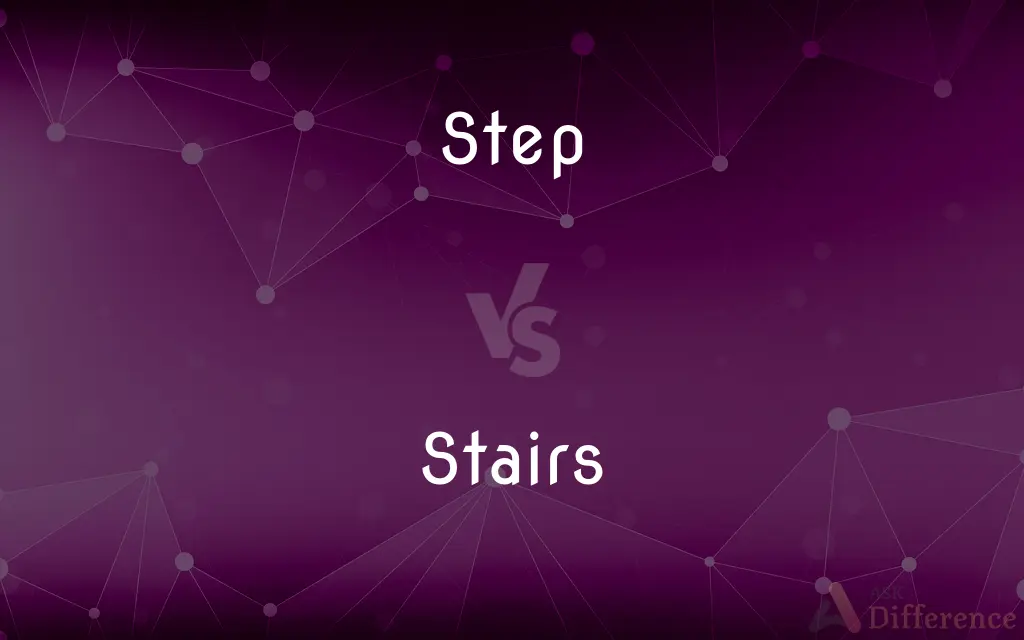Step vs. Stairs — What's the Difference?
By Tayyaba Rehman & Urooj Arif — Updated on April 16, 2024
A step refers to a single level in a series, used for ascending or descending, whereas stairs (or a staircase) refer to the entire structure of linked steps facilitating vertical movement between floors or levels.

Difference Between Step and Stairs
Table of Contents
ADVERTISEMENT
Key Differences
A step is a single section of a staircase that you place your foot on when ascending or descending. On the other hand, stairs refer to a complete set of steps that collectively make up a stairway, allowing people to move from one level to another.
In construction and architecture, the design of a step focuses on its depth, height, and tread, tailored to ensure safety and comfort in foot traffic. Whereas, the design of stairs encompasses not only the individual steps but also elements like handrails, landings, and balusters, which contribute to the overall functionality and safety of the stairway.
Typically, the term "step" can also metaphorically represent a phase or stage in a process, illustrating progression or a change in state. Meanwhile, "stairs" rarely see such metaphorical use, being more concrete in their reference to physical structures.
When it comes to maintenance and discussion in home improvement, you might consider the repair or replacement of a damaged step. On the other hand, discussions about stairs usually involve considerations of the entire staircase, which might include upgrading or modifying the stairwell for better access or aesthetic appeal.
While a step could be part of various environments, including outdoor landscapes or machines, and isn't limited to staircases, stairs specifically denote the collective assembly within buildings or structures dedicated to bridging vertical distances.
ADVERTISEMENT
Comparison Chart
Definition
A single level or surface to put your foot on
A series of steps forming a passage between floors
Usage Context
Can be individual or part of stairs
Always refers to the collective structure
Metaphorical Usage
Commonly used to denote phases in processes
Rarely used metaphorically
Components
Comprises only the surface tread
Includes steps, handrails, landings, etc.
Variability
Can vary widely in design individually
Variability depends on overall design and structure
Compare with Definitions
Step
A strong action taken in pursuit of an objective.
Taking legal action was a necessary step.
Stairs
Can refer to a whole staircase, including all architectural elements.
The old wooden stairs creaked loudly.
Step
A single flat surface of a staircase meant for placing the foot.
Be careful on the icy step outside.
Stairs
Used to indicate movement between different levels in a structure.
Fire exits must be kept clear of obstructions on the stairs.
Step
A measure or action, particularly one of a series taken in order to deal with or achieve something.
The company is taking steps to improve efficiency.
Stairs
A set of steps leading from one floor of a building to another.
The book fell down the stairs.
Step
A phase in a sequence of events or processes.
The first step in the recipe is to preheat the oven.
Stairs
Often used in plural form to refer to more than one step collectively.
She raced up the stairs to answer the phone.
Step
A movement made by lifting the foot and setting it down in another location.
He took a step back in surprise.
Stairs
Sometimes used to describe the act of climbing or descending in a building.
Taking the stairs instead of the elevator is great exercise.
Step
The single complete movement of raising one foot and putting it down in another spot, as in walking.
Stairs
Stairs, a stairway, a staircase, a stairwell, or a flight of stairs is a construction designed to bridge a large vertical distance by dividing it into smaller vertical distances, called steps. Stairs may be straight, round, or may consist of two or more straight pieces connected at angles.
Step
A manner of walking; a particular gait.
Stairs
Often stairs A series or flight of steps; a staircase.
Step
A fixed rhythm or pace, as in marching
Keep step.
Stairs
One of a flight of steps.
Step
The sound of a footstep.
Stairs
Plural of stair
Step
A footprint
Steps in the mud.
Stairs
A contiguous set of steps connecting two floors.
Step
The distance traversed by moving one foot ahead of the other.
Stairs
A way of access consisting of a set of steps
Step
A very short distance
Just a step away.
Step
Steps Course; path
Turned her steps toward home.
Step
One of a series of rhythmical, patterned movements of the feet used in a dance
Diagrammed the basic steps to the mambo.
Step
A rest for the foot in ascending or descending.
Step
Steps Stairs.
Step
Something, such as a ledge or an offset, that resembles a step of a stairway.
Step
A low platform used for exercise, as in step aerobics.
Step
One of a series of actions, processes, or measures taken to achieve a goal.
Step
A stage in a process
Followed every step in the instructions.
Step
A degree in progress or a grade or rank in a scale
A step up in the corporate hierarchy.
Step
The interval that separates two successive tones of a scale, especially a major second, as between C and D in the scale of C major.
Step
A degree of a scale.
Step
(Nautical) The block in which the heel of a mast is fixed.
Step
To put or press the foot
Step on the brake.
Step
To shift or move slightly by taking a step or two
Step back.
Step
To walk a short distance to a specified place or in a specified direction
Step over to the corner.
Step
To move with the feet in a particular manner
Step lively.
Step
To move into a new situation by or as if by taking a single step
Stepping into a life of ease.
Step
To treat someone with arrogant indifference
He is always stepping on other people.
Step
To put or set (the foot) down
Step foot on land.
Step
To measure by pacing
Step off ten yards.
Step
To furnish with steps; make steps in
Terraces that are stepped along the hillside.
Step
(Computers) To cause (a computer) to execute a single instruction.
Step
(Nautical) To place (a mast) in its step.
Step
An advance or movement made from one foot to the other; a pace.
Step
A rest, or one of a set of rests, for the foot in ascending or descending, as a stair, or a rung of a ladder.
Step
The part of a spade, digging stick or similar tool that a digger's foot rests against and presses on when digging; an ear, a foot-rest.
Step
A distinct part of a process; stage; phase.
He improved step by step, or by steps.
The first step is to find a job.
Step
A running board where passengers step to get on and off the bus.
The driver must have a clear view of the step in order to prevent accidents.
Step
The space passed over by one movement of the foot in walking or running.
One step is generally about three feet, but may be more or less.
Step
A small space or distance.
It is but a step.
Step
A print of the foot; a footstep; a footprint; track.
Step
A gait; manner of walking.
The approach of a man is often known by his step.
Step
Proceeding; measure; action; act.
Step
(in the plural) A walk; passage.
Step
(in the plural) A portable framework of stairs, much used indoors in reaching to a high position.
Step
(nautical) A framing in wood or iron which is intended to receive an upright shaft; specifically, a block of wood, or a solid platform upon the keelson, supporting the heel of the mast.
Step
(machines) One of a series of offsets, or parts, resembling the steps of stairs, as one of the series of parts of a cone pulley on which the belt runs.
Step
(machines) A bearing in which the lower extremity of a spindle or a vertical shaft revolves.
Step
(music) The interval between two contiguous degrees of the scale.
Usage note: The word tone is often used as the name of this interval; but there is evident incongruity in using tone for indicating the interval between tones. As the word scale is derived from the Italian scala, a ladder, the intervals may well be called steps.
Step
(kinematics) A change of position effected by a motion of translation.
Step
(programming) A constant difference between consecutive values in a series.
Printing from 0 to 9 with a step of 3 will display 0, 3, 6 and 9.
Step
(colloquial) A stepchild.
Step
(slang) A stepsibling.
Step
(intransitive) To move the foot in walking; to advance or recede by raising and moving one of the feet to another resting place, or by moving both feet in succession.
Step
(intransitive) To walk; to go on foot; especially, to walk a little distance.
To step to one of the neighbors
Step
(intransitive) To walk slowly, gravely, or resolutely.
Step
To dance.
Step
To move mentally; to go in imagination.
Step
(transitive) To set, as the foot.
Step
To fix the foot of (a mast) in its step; to erect.
Step
To move the foot in walking; to advance or recede by raising and moving one of the feet to another resting place, or by moving both feet in succession.
Step
To walk; to go on foot; esp., to walk a little distance; as, to step to one of the neighbors.
Step
To walk slowly, gravely, or resolutely.
Home the swain retreats,His flock before him stepping to the fold.
Step
Fig.: To move mentally; to go in imagination.
They are stepping almost three thousand years back into the remotest antiquity.
Whosoever then first, after the troubling of the water, stepped in, was made whole of whatsoever disease he had.
Step
To set, as the foot.
Step
To fix the foot of (a mast) in its step; to erect.
Step
An advance or movement made by one removal of the foot; a pace.
Step
A rest, or one of a set of rests, for the foot in ascending or descending, as a stair, or a round of a ladder.
The breadth of every single step or stair should be never less than one foot.
Step
The space passed over by one movement of the foot in walking or running; as, one step is generally about three feet, but may be more or less. Used also figuratively of any kind of progress; as, he improved step by step, or by steps.
To derive two or three general principles of motion from phenomena, and afterwards to tell us how the properties and actions of all corporeal things follow from those manifest principles, would be a very great step in philosophy.
Step
A small space or distance; as, it is but a step.
Step
A print of the foot; a footstep; a footprint; track.
Step
Gait; manner of walking; as, the approach of a man is often known by his step.
Step
Proceeding; measure; action; an act.
The reputation of a man depends on the first steps he makes in the world.
Beware of desperate steps. The darkest day,Live till to-morrow, will have passed away.
I have lately taken steps . . . to relieve the old gentleman's distresses.
Step
Walk; passage.
Conduct my steps to find the fatal tree.
Step
A portable framework of stairs, much used indoors in reaching to a high position.
Step
In general, a framing in wood or iron which is intended to receive an upright shaft; specif., a block of wood, or a solid platform upon the keelson, supporting the heel of the mast.
Step
One of a series of offsets, or parts, resembling the steps of stairs, as one of the series of parts of a cone pulley on which the belt runs.
Step
The intervak between two contiguous degrees of the csale.
Step
A change of position effected by a motion of translation.
Step
At Eton College, England, a shallow step dividing the court into an inner and an outer portion.
Step
Any maneuver made as part of progress toward a goal;
The situation called for strong measures
The police took steps to reduce crime
Step
The distance covered by a step;
He stepped off ten paces from the old tree and began to dig
Step
The act of changing location by raising the foot and setting it down;
He walked with unsteady steps
Step
Support consisting of a place to rest the foot while ascending or descending a stairway;
He paused on the bottom step
Step
Relative position in a graded series;
Always a step behind
Subtle gradations in color
Keep in step with the fashions
Step
A short distance;
It's only a step to the drugstore
Step
The sound of a step of someone walking;
He heard footsteps on the porch
Step
A musical interval of two semitones
Step
A mark of a foot or shoe on a surface;
The police made casts of the footprints in the soft earth outside the window
Step
A solid block joined to the beams in which the heel of a ship's mast or capstan is fixed
Step
A sequence of foot movements that make up a particular dance;
He taught them the waltz step
Step
Shift or move by taking a step;
Step back
Step
Put down or press the foot, place the foot;
For fools rush in where angels fear to tread
Step on the brake
Step
Cause (a computer) to execute a single command
Step
Treat badly;
This boss abuses his workers
She is always stepping on others to get ahead
Step
Furnish with steps;
The architect wants to step the terrace
Step
Move with one's feet in a specific manner;
Step lively
Step
Walk a short distance to a specified place or in a specified manner;
Step over to the blackboard
Step
Place (a ship's mast) in its step
Step
Measure (distances) by pacing;
Step off ten yards
Step
Move or proceed as if by steps into a new situation;
She stepped into a life of luxury
He won't step into his father's footsteps
Common Curiosities
How does the metaphorical use of 'step' work?
Metaphorically, 'step' is used to describe stages or actions in a process, indicating progression.
What materials are commonly used to build steps?
Common materials for building steps include wood, stone, concrete, and metal, depending on the environment and structural needs.
What is a step in terms of construction?
In construction, a step refers to a single section of a stairway where you place your foot to ascend or descend.
How can steps be made safer for children and the elderly?
Adding non-slip surfaces, ensuring there are handrails, and maintaining an appropriate riser height can make steps safer for children and the elderly.
Are all stairs straight?
No, stairs can be designed in various configurations, including straight, spiral, curved, or with landings.
Can stairs consist of just one step?
Technically, stairs imply a series of steps, so a single step does not constitute stairs.
What are the safety features considered in stairs design?
Safety features in stairs design include non-slip treads, adequate step height and depth, handrails, and proper lighting.
Is there a standard height for a step?
Yes, the standard height for a step, often called the riser, is typically around 7 inches (18 cm), but it can vary based on building codes and the staircase design.
Can the term 'stairs' be used for a single step?
No, 'stairs' refers to a sequence of two or more steps.
How do steps differ when used outside versus inside?
Outdoor steps often have considerations for weather resistance and durability, whereas indoor steps may focus more on aesthetics and comfort.
How are steps measured for safety and compliance?
Steps are measured by their riser height, tread depth, and overall width to ensure they comply with safety standards and building regulations.
What are 'service stairs'?
Service stairs are secondary stairways typically used for service access or as a backup to the main stairs, often found in commercial or large residential buildings.
What is the role of a landing in a staircase?
A landing is an intermediate platform found between long flights of stairs, providing a rest point and often helping to change the direction of the stairway.
How do building codes affect stair design?
Building codes dictate specific dimensions and safety features for stairs to ensure they are safe and accessible for all users.
What is a staircase baluster?
A baluster is a vertical moulding, spindle, or post that supports the handrail of a staircase.
Share Your Discovery

Previous Comparison
Constrain vs. Constraint
Next Comparison
Fax vs. FacsimileAuthor Spotlight
Written by
Tayyaba RehmanTayyaba Rehman is a distinguished writer, currently serving as a primary contributor to askdifference.com. As a researcher in semantics and etymology, Tayyaba's passion for the complexity of languages and their distinctions has found a perfect home on the platform. Tayyaba delves into the intricacies of language, distinguishing between commonly confused words and phrases, thereby providing clarity for readers worldwide.
Co-written by
Urooj ArifUrooj is a skilled content writer at Ask Difference, known for her exceptional ability to simplify complex topics into engaging and informative content. With a passion for research and a flair for clear, concise writing, she consistently delivers articles that resonate with our diverse audience.















































